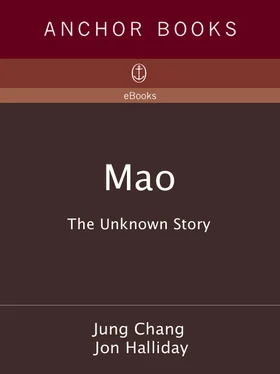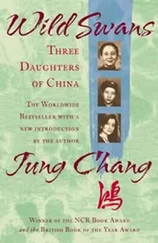Two months before, on 25 June, Mao had already issued two press releases giving himself this title. No newspapers seem to have carried these, but Mao pasted them up as notices. Shanghai’s reaction had been to announce on 1 August that the post of chairman belonged to the Party’s (nominal) general secretary, Hsiang Chung-fa. Mao was now reiterating his self-appointment over Hsiang’s head, in defiance of Shanghai.
But Mao received no punishment. The new Red state that Moscow had decided to install in China needed power-hungry leaders, and Mao was the hungriest around. On 20 September his second-level membership of the Politburo was restored, paving the way to top jobs in the coming Red state. Moscow had rejected Wuhan as the location, ordering the state to be established in “the Red Army’s largest secure region”—which was Red Jiangxi.
The defeat and heavy casualties inflicted by Mao’s siege of Changsha were blamed on the impulsive Li Li-san. Li-san had told the Russians it was their “internationalist duty” to send in troops to help the Chinese Reds in their fight. During the Russian invasion of Manchuria the year before, he had gladly called for the Chinese Reds to “defend the Soviet Union with arms.” Now he proposed that Moscow should reciprocate, and this riled Stalin, who suspected Li-san of trying to drag him into war with Japan. Li-san had also incurred Stalin’s ire by saying that Mongolia, which Soviet Russia had annexed from China, should become part of Red China. The Comintern condemned Li-san on 25 August for being “hostile to Bolshevism, and hostile to the Comintern,” and in October a letter arrived ordering him to Moscow. There Stalin turned him into a kind of all-purpose scapegoat, and he was repeatedly called on to stand up and denounce himself. †Li-san entered history books as the man responsible for all the Red losses in the early 1930s. High on the list of losses were those suffered during the siege of Changsha, which were in fact entirely Mao’s responsibility, incurred for his own personal power.
MAO’S QUEST FOR POWER also brought tragedy to his family. In 1930 his ex-wife Kai-hui and their three young sons, the youngest three years old, were still living in her family home on the outskirts of Changsha when Mao laid siege to the city.
Mao had left them exactly three years before, when he set off, ostensibly to take part in an “Autumn Harvest Uprising,” but actually to poach his first armed force. Barely four months after his departure, he had married somebody else.
Although Changsha was ruled by a fiercely anti-Communist general, Ho Chien, Kai-hui had been left alone, as she was not engaged in Communist activities. Even after Peng De-huai had taken Changsha and nearly killed him, Ho Chien took no reprisals against her. But after Mao turned up and subjected the city to a second lengthy assault, the Nationalist general decided to take revenge. Kai-hui was arrested together with her eldest son, An-ying, on An-ying’s eighth birthday, 24 October. She was offered a deal: her freedom if she would make a public announcement divorcing Mao and denouncing him. She refused, and was executed on the cloudy morning of 14 November 1930. Next day the Hunan Republican Daily reported her death under the headline “Wife of Mao Tse-tung executed yesterday — everyone claps and shouts with satisfaction.” This undoubtedly reflected more loathing of Mao than of Kai-hui.
When Kai-hui was brought into the “court” in army HQ, wearing a long dark blue gown, she showed no sign of fear. There on a desk were placed a brush, some red ink, and a sticker with her name on it. After asking a few questions, the judge ticked the sticker with the brush dipped in the red ink, and threw it on the floor. This was the traditional equivalent of signing a death warrant. At this, two executioners peeled off her gown as spoils. Another found a bonus—2.5 yuan wrapped in a handkerchief in one of the pockets.
And so she went to her death, on a winter day, wearing a thin blouse, at the age of twenty-nine. As she was taken through the streets, tied up with ropes, which was the normal treatment for someone about to be executed, an officer hailed a rickshaw for her, while soldiers ran along on both sides. The execution ground lay just beyond one of the city gates, among the graves of the people executed who had no one to take their bodies home. After they shot her, some of the firing squad took off her shoes and threw them as far as they could: otherwise, legend went, they would be followed home and haunted by the ghost of the dead.
As the executioners were having lunch afterwards at their barracks, they were told that Kai-hui was not dead, so seven of them went back and finished her off. In her agony her fingers had dug deep into the earth.
Her body was taken back to her village by relatives, and buried in the grounds of her family home. Her son was released, and early in 1931 Mao’s brother Tse-min arranged for the three boys to travel to Shanghai, where they entered a secret CCP kindergarten.
When Mao learned of Kai-hui’s death, he wrote in what seems to have been genuine grief: “The death of Kai-hui cannot be redeemed by a hundred deaths of mine!” He spoke of her often, especially in his old age, as the love of his life. What he never knew is that although Kai-hui did love him, she had also rejected his ideology and his killings.
IN THE YEARS between Mao deserting her and her death, Kai-hui wrote reflections on communism, and on her love for Mao, in eight intense, forgiving and occasionally reproachful pieces, which she concealed in her house. Seven were discovered in cracks in the walls in 1982, during some renovation work. The eighth came to light under a beam just outside her bedroom during repairs in 1990. She had wrapped them up in wax paper to protect them from damp. Mao never saw them, and most are still kept secret — so secret that even Mao’s surviving family were barred from seeing the most devastating passages.
The writings show the pain Kai-hui suffered from Mao’s desertion, her disappointment and bitterness at his heartlessness towards her and their sons — and, perhaps more damning, her loss of faith in communism.
The earliest piece is a poem, “Thoughts,” dated October 1928. Mao had been gone for a year, and had only written once. He had mentioned having trouble with his feet. In June, when a CCP inspector she referred to as “First Cousin” went off to Mao’s area, she gave him a jug of chili with fermented beans, Mao’s favorite dish, to take to her husband. But there was no reply. On a cold day, Kai-hui missed Mao:
Downcast day a north wind starts ,
Thick chill seeps through flesh and bones .
Thinking of this Far-away Man ,
Suddenly waves churn out of calm .
Is the foot trouble healed?
Is the winter clothing ready?
Who cares for you while you sleep alone?
Are you as lonely and sad as I am?
No letters are coming through ,
I ask, but no one answers .
How I wish I had wings ,
Fly to see this man .
Unable to see him ,
Sorrow, it has no end …
The next piece, written to First Cousin in March 1929, and marked “not sent,” talks about her loneliness and her yearning for support:
I cower in a corner of the world. I am frightened and lonely. In this situation, I search every minute for something to lean on. So you take a place in my heart, and so does Ren-xiu who is staying here — you both stand side by side in my heart! I often pray: “Please don’t let these few people be scattered!” I seem to have seen the God of Death — ah, its cruel and severe face! Talking of death, I do not really fear it, and I can say that I welcome it. But my mother, and my children! I feel pity for them! This feeling haunts me so badly — the night before last it kept me half awake all night long.
Читать дальше










